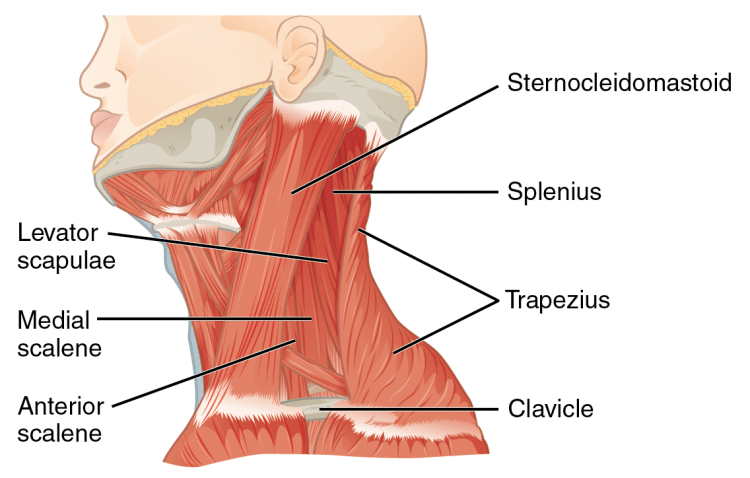If you read our article on exercises for nerd neck and desk slouch, you already know how sedentarism and spending too much time on your phone or laptop can wreak havoc on your posture. Extended periods in anything other than good posture puts a lot of tension on tissues and joints that were never really meant to be loaded so heavily.
Your body adapts to the stresses placed on it, and if you spend most of your day hunched over, it will become accustomed to that position and adopt it even if you aren’t using your phone or working on your computer.
This is the same adaptive mechanism that builds muscle mass in response to strength training and improves your fitness when you do cardio.
However, while muscle mass and better fitness are positive adaptations, poor posture is almost always negative.
One of the muscles most affected by habitual poor posture is the levator scapulae. This lesser-known muscle has the propensity to become tight and can cause various unpleasant symptoms, including neck pain and headaches.
Level Up Your Fitness: Join our 💪 strong community in Fitness Volt Newsletter. Get daily inspiration, expert-backed workouts, nutrition tips, the latest in strength sports, and the support you need to reach your goals. Subscribe for free!
The good news is that the levator scapulae are both easy to stretch and very receptive to stretching, so it won’t take much time or effort to restore it to their correct length and tension.
In this article, we introduce you to your levator scapulae, explain why they can become overly tight, and reveal the best stretches for releasing them.
Levator Scapulae 101
There are over 600 named muscles in the human body, and most have Latin-based names. In many cases, these names reveal the location and/or function of the muscle in question. For example, the biceps brachii means the two-headed arm muscle, latissimus dorsi means side back muscle, and rectus abdominis means straight or flat abdominal muscle.
Clever, right?!
So, what does that say about the levator scapulae, or lev scap, to all you anatomy geeks?
The levator scapulae are named after their primary function, which is the elevation of the scapulae or shoulder blades. It is a superficial neck muscle, meaning it’s located close to the surface. The levator scapulae have several functions, including:
- Lifting your shoulders
- Tilting your head to the side
- Squeezing your shoulder blades together
- Tilting your shoulder blades
You probably don’t do any exercises for your levator scapulae, but you still use them pretty frequently without realizing it. Lev scap are intensely involved in many athletic activities, including freestyle swimming, racket sports, lifting, and throwing.
When your levator scapulae are working well, you probably won’t even know they’re there. However, when they get tight, they can cause all sorts of problems, and then they’re hard to ignore.
Common Causes of Levator Scapulae Tightness
Muscles usually become short and tight because they spend too much time in a shortened, tightened position. However, sometimes they tighten up in response to a trauma or injury.
Common causes of levator scapular rightness include:
- Cervical spine dysfunction.
- Spending prolonged periods looking down at a laptop or tablet.
- Long periods spent reading.
- Using your phone too much.
- Poor sleeping position, e.g., using too many pillows or sleeping on your stomach with your head turned to the side.
- Emotional stress.
- Carrying a heavy bag on the same shoulder too often or too long.
- Repetitive arm actions, such as swimming, throwing, or racket sports.
- Repetitive neck movements, such as watching a game of tennis.
- Violent neck movements, such as a side-on car crash or getting caught with a cross in boxing.
So, as you can see, in many cases, YOU are the reason you’ve got tight levator scapulae. Changing your habits could help alleviate lev scap tightness or even stop it before it starts. However, if you are reading this, you probably already have tight levator scapulae muscles and want to know how to fix them.
Don’t worry – we’ll get to that soon…
What Happens When Your Levator Scapulae Become Tight?
Levator scapulae tightness is a common problem. In fact, it’s so common that pain associated with this muscle is sometimes called levator scapulae syndrome. And you know when you see the word syndrome that things just got real!
The symptoms of levator scapulae syndrome include (1):
- Neck pain.
- Restricted range of movement, especially cervical (neck) flexion, and lateral flexion.
- Tightness and/or pain in the upper back, especially along the top of the scapulae.
- Tenderness, inflammation, and localized trigger points.
Many of these symptoms are the result of poor blood flow and the subsequent accumulation of waste products within the muscle.
Muscles are made from bundles of muscle fibers. Not just one bundle but bundles of bundles. When a muscle is short and tight, blood cannot flow through it as freely as usual, and that’s where the trouble starts.
Tight muscles are actually semi-contracted all the time. Think of a rope being pulled tight and how the fibers get squeezed together as a result. That’s what happens to your muscles.
Reducing muscle tension will restore normal blood flow, leading to the removal of waste products and less irritation and inflammation.
The 7 Best Stretches for Your Levator Scapula
Are your levator scapulae being a pain in the neck? In many cases, gentle stretching is the answer. However, if your symptoms get worse or don’t get better within a couple of weeks, something more serious might be happening. You should seek medical advice from a doctor, physio, chiropractor, or similar.
- Basic levator scapulae stretch
- Assisted levator scapulae stretch
- Standing modified levator scapulae stretch
- Band-assisted levator scapulae stretch
- Seated assisted levator scapulae stretch
- Levator scapulae self-massage
- Trigger pointing the levator scapulae
1. Basic levator scapulae stretch
In most cases, this is the only stretch you need to lengthen and relax your lev scap. It’s simple, can be done seated or standing, and is usually very effective. It’s also a very gentle stretch, so it’s ideal if your lev scap feels tender or sore.
Level Up Your Fitness: Join our 💪 strong community in Fitness Volt Newsletter. Get daily inspiration, expert-backed workouts, nutrition tips, the latest in strength sports, and the support you need to reach your goals. Subscribe for free!
Steps:
- Seated or standing, turn your head 45 degrees to the left.
- Next, bend your neck downward as though you are looking into a shirt pocket.
- Hold this for 30 to 60 seconds, and then ease out of the stretch.
- Swap sides and repeat.
2. Assisted levator scapulae stretch
This stretch is designed to ease your levator scapulae into a more lengthened position. Start with the basic version and then progress to this variation if you feel it’s necessary. However, take care NOT to pull on your head too hard, as you could end up making matters worse. Placing your opposite hand behind your back helps keep your shoulder down, increasing the stretch in the target muscle.
Steps:
- Seated or standing, turn your head 45 degrees to the left.
- Place your left hand on your head and your right hand behind your back.
- Next, bend your neck downward, pulling gently with your left arm to stretch your neck a little further.
- Hold this for 30 to 60 seconds, and then ease out of the stretch.
- Swap sides and repeat.
3. Standing modified levator scapulae stretch
The great thing about this levator scapulae stretch is that you can do it without anyone really noticing. This makes it ideal for doing at work, school, while waiting in line to pay for your groceries, or during a conversation with a boring friend or relative! Do it whenever your lev scap feels tight or just to pass the time.
Steps:
- Stand with your feet about shoulder-width apart. Adopt a good posture with your head up and shoulders down and back.
- Cross your left arm in front of your body and hold your left wrist with your right hand.
- Lower your head down toward your chest and then rotate your chin towards your right armpit.
- Hold for 30 to 60 seconds, relax, and swap sides.
- You can also do this exercise with your hands behind your back. This may create a slightly deeper stretch, but you’ll look more obvious while you’re doing it.
4. Band-assisted levator scapulae stretch
The levator scapulae’s primary function elevation of your shoulder blades. Therefore, to stretch this muscle effectively, you must keep your shoulders down, which is a movement called depression. This banded exercise gently forces your shoulders into depression, making it far easier to get a good lev scap stretch.
Steps:
- Stand in good posture, with your head up and shoulders down and back. Hold a resistance band in your left hand and stand on the other end. Your arm should be by your side. Shorten the bend so that it pulls your left shoulder down into depression.
- Next, turn your head 45 degrees to the right, and lower your chin down toward your chest.
- Hold this position for 30 to 60 seconds.
- Move your head a few degrees in either direction to seek out areas of tightness.
- Relax, switch sides, and repeat.
5. Seated assisted levator scapulae stretch
No resistance band to do exercise #4? No problem? You can do this exercise seated and use the side of a chair to keep your shoulder girdle depressed. This is an excellent exercise to break up long periods working at your computer and can help reverse the damaging effects of prolonged sitting.
Steps:
- Sit up in your chair, so you’re in good posture. Your feet should be planted firmly on the floor, knees bent to 90 degrees. Look straight ahead.
- Reach down with your right arm and grab the side of your chair next to your hip. Use your arm to pull your shoulder down.
- Next, rotate your head 45 degrees to the left and then lower your chin toward your chest.
- Hold for 30-60 seconds, and then relax and change sides.
6. Levator scapulae self-massage
Few things are better for muscle tension than a good massage. While you could pay for a massage, it’s pretty straightforward to massage your levator scapulae yourself. A couple of minutes of self-massage before, after, or instead of stretching can help ease the tension from your lev scap and alleviate pain.
Steps:
- Sitting comfortably in good posture, place your fingers on the outside of the back of your neck.
- Turn your head 45 degrees and lower your chin down toward your chest.
- Use your fingers to gently massage the length and breadth of the levator scapula.
- Spend extra time on any areas that feel especially tight or painful.
- Relax, swap sides, and repeat.
7. Trigger pointing the levator scapulae
Trigger points are localized areas of tension where fascia and muscle fibers get “gummed up.” Applying gentle progressing to firm pressure helps alleviate trigger points, relieving the pain they cause. You can treat trigger points with massage, but this more targeted approach often works best.
Steps:
- Using your fingers or a small, firm ball such as a golf or massage ball, palpate the lateral/rear part of your neck to locate any hot spots or concentrated areas of tension.
- Next, gently press on the trigger point until you feel it ease.
- Increase the pressure, and again continue until you feel it ease.
- Repeat this sequence 1-2 more times, gradually increasing the pressure, and the trigger point “melts.”
- Relax, switch sides, and repeat.
- You can also have someone do this for you.
- Alternatively, you can place the ball between your neck and the wall or floor, lean against it, and create pressure with your body weight.
FAQs
Do you have a question about levator scapulae stretches or neck stretching in general? We’ve got the answers you seek!
1. How often should I stretch my levator scapulae?
If your levator scapulae are very tight and cause symptoms like headaches and neck pain, you should probably stretch them several times a day. That’s also the case if you spend a lot of time hunched over your computer or phone.
However, if your lev scap doesn’t really cause you any problems, you don’t need to stretch them as often, and a few times a week should be sufficient.
Adjust the frequency and duration of your lev scap stretches based on your needs. The tighter you are, the more often you should stretch.
2. My neck hurts when I stretch my levator scapulae. What am I doing wrong?
While a bit of discomfort is normal when stretching a very tight muscle, it should be restricted to the muscle you’re working on. For example, pain in your cervical spine (neck) suggests that you are either trying to stretch too far or there is an issue with the spine itself.
So, ease off the stretch, and if that doesn’t solve the problem, get some medical advice as there may be an underlying neck issue causing pain.
3. How can I stop my levator scapulae from tightening up?
Muscles tend to shorten with a lack of use. Also, adopting and maintaining a shortened position will make your muscles tighten up. Modern life is very sedentary, and many of us spend long periods “locked in” the same position for many hours each day.
For example, if you work with a computer, you could conceivably spend eight or more hours hunched over your keyboard. It’s no wonder that desk warriors have stiff necks! We then compound the problem by spending much of our leisure time bent over our phones and tablets.
So, the best way to prevent all this tightness is to sit less and move more. Try to take all your joints through a large range of motion as often as you can.
One way to do this is to set an alarm to sound every hour, and when it goes off, get up and move for five minutes. Shrug and roll your shoulders, rotate your neck, flex your hips, rotate your spine, bend your knees, and circle your ankles. This will help offset the effects of prolonged sitting.
If you notice any muscles feel tight, stretch them for a few seconds before getting back to work.
4. Do I even need to stretch my levator scapulae?
Only you know the answer to this question! If your lev scap feel fine, and there are no tension or trigger points, stretching them may be unnecessary. But, if you have any of the symptoms associated with levator scapulae syndrome, you should probably spend time stretching these often overworked muscles.
5. What is the best way to stretch my levator scapulae?
Stretches generally work best when you ease into them. Pick one of the exercises above and apply the stretch until you feel a mild pulling sensation in the target muscle. Hold this position, called the point of bind, for 10-15 seconds. During this time, you should feel the muscle relax.
Then, move into a slightly deeper stretch until you reach the next point of bind. Again, hold this position for 10-15 seconds or until you feel the muscle relax.
Repeat this sequence several times until the muscle feels thoroughly stretched and relaxed.
Levator Scapulae Stretches – Wrapping Up
Tight levator scapulae can be a real pain in the neck! It’s such a common problem that it has a whole syndrome named after it. A tight lev scap can cause a wide range of issues, including neck pain, headaches, tenderness, pain, and restricted movement.
Unfortunately, the cause of levator scapulae tightness can be hard to avoid – modern living. Working at a computer and spending time hunched over your phone are the main culprits, although your sleeping position and traumatic neck injury are also known causes.
The good news is that the lev scap are very easy to stretch, and you can even work on them while you’re sitting at your desk.
So, don’t let levator scapulae tightness get you down. Instead, use the stretches in this article to ease tension and restore them to their proper length.
References:
1– PubMed: Levator scapulae syndrome: an anatomic-clinical study https://pubmed.ncbi.nlm.nih.gov/8374486/












